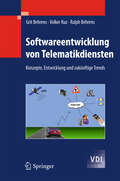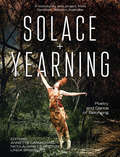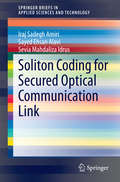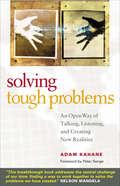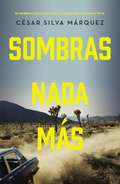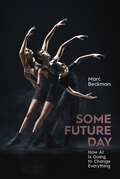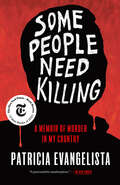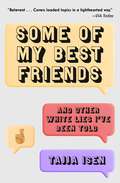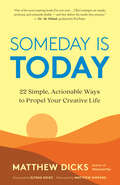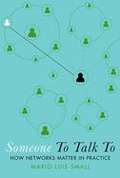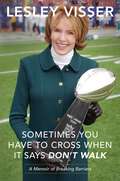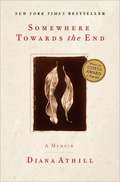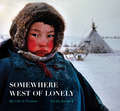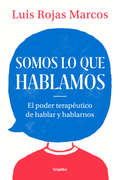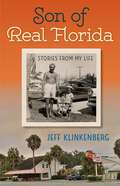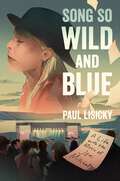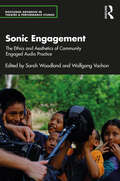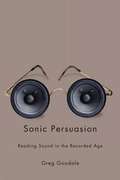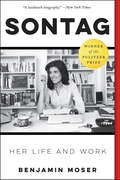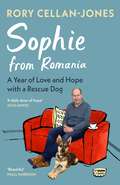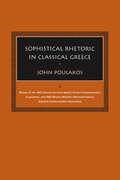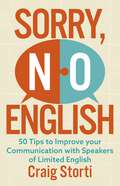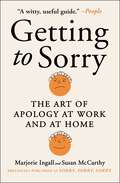- Table View
- List View
Softwareentwicklung von Telematikdiensten
by Grit Behrens Volker Kuz Ralph BehrensDas Buch vermittelt einen Einstieg in die Software-Entwicklung von Telematikdiensten mit einem Eclipse-Plugin für das Common Service Framework (Open Source). Ziel ist es, Nutzer dazu zu befähigen, internetbasierte Telematikdienste selbst zu programmieren. Begleitend zum Buch steht ein Internetportal bereit, wo Beispielapplikationen demonstriert, getestet oder weiter entwickelt werden können. Es gibt des Weiteren Einblick in die Hintergründe und die weltweiten Zukunftsentwicklungen auf dem rasant anwachsenden Gebiet der Telematikdienste.
Solace + Yearning – Poetry of Dance and Belonging: A Community Arts Project from Denmark, Western Australia
by Annette Carmichael‘Solace + Yearning’ layers landscape, poetry, eco-art and contemporary dance to create an immersive space for many voices: yearning to connect to country, grief for what is absent, and reaching towards an understanding of indigenous language and culture. “Along the edges, voices call softly, softly… the past speaking to the present.” This multi-arts collaboration explores ‘settler guilt’ and ‘solastalgia’—a sense of loss caused by environmental change—in a small rural community. The work unravels contradictory and complicated feelings about Australia’s stories, the assumed advantage of non-indigenous Australians, and yet our deep longing for the wisdom and connection intrinsic in indigenous cultures. “It is beneath the bark where stories are whispered and life rises to stitch together this river with this sky.” Performed in Denmark, Western Australia in 2012, and again as a solo performance by Annette Carmichael in 2014, these images and reflections portray a complex relationship between people and place. “Sometimes, sometimes I make the mistake of thinking that what has not been written down has been forgotten.” With gratitude to Joey Williams, Wayne Webb, Toni Webb, and Harley Coyne, who walked the trail with us and generously shared their Noongar culture and stories.
Soliton Coding for Secured Optical Communication Link
by Iraj Sadegh Amiri Sayed Ehsan Alavi Sevia Mahdaliza IdrusNonlinear behavior of light such as chaos can be observed during propagation of a laser beam inside the microring resonator (MRR) systems. This Brief highlights the design of a system of MRRs to generate a series of logic codes. An optical soliton is used to generate an entangled photon. The ultra-short soliton pulses provide the required communication signals to generate a pair of polarization entangled photons required for quantum keys. In the frequency domain, MRRs can be used to generate optical millimetre-wave solitons with a broadband frequency of 0-100 GHz. The soliton signals are multiplexed and modulated with the logic codes to transmit the data via a network system. The soliton carriers play critical roles to transmit the data via an optical communication link and provide many applications in secured optical communications. Therefore, transmission of data information can be performed via a communication network using soliton pulse carriers. A system known as optical multiplexer can be used to increase the channel capacity and security of the signals.
Solving Tough Problems: An Open Way of Talking, Listening, and Creating New Realities
by Adam Kahane&“This breakthrough book addresses the central challenge of our time: finding a way to work together to solve the problems we have created.&” —Nelson Mandela Adam Kahane has worked on some of the toughest, most complex problems in the world. He started out as an expert analyst and advisor to corporations and governments, convinced of the need to calculate &“the one right answer.&” After an unexpected experience in South Africa during the transition away from apartheid, he got involved in facilitating a series of extraordinary high-conflict, high-stakes problem-solving efforts: in Colombia during the civil war, in Argentina during the collapse, in Guatemala after the genocide, in Israel, Northern Ireland, Cyprus, and the Basque Country. Through these experiences, he learned to create environments that enable new ideas and creative solutions to emerge even in the most stuck, polarized contexts. Here Kahane tells his stories and distills from them an approach all of us can use to solve our own toughest problems—at home, at work, in our communities, and in national and international affairs. &“Thought-provoking (occasionally verging on spiritual) discourse on handling difficult situations gracefully, productively and calmly.&” —Publishers Weekly &“Many people have written about the healing power of dialogue. None, however, has put that power to the test under more extreme conditions with greater success than Adam Kahane. Informative, inspiring, and beautifully written.&” —David Korten, President of the People-Centered Development Forum, and author of When Corporations Rule the World &“This generative dialogue approach offers real opportunities for governments to engage with stakeholders to build trust and create exciting new resolutions to multi-faceted social and governance challenges.&” —Clare Beckton, Assistant Deputy Attorney General of Canada
Sombras nada más
by César Silva MárquezLuis Kuriaki suffers from the harassment of his nightmares, derived from the murder of his beautiful girlfriend Verónica Mancera, for which he becomes obsessed with solving the murder of the young woman. As the plot unfolds, all the stories intertwine in a voracious spiral of delusions and persecution, the epicenter of which is the iconic Ciudad Juárez. The speed of emotions and the moral decay of a society, spurred on by the millions of dollars, often dirty, that feed, but also corrupt, this city, are blurring the division between good and bad.We are facing a luminous narrative portrait of decadence and hope, in every sense of the word. Mafiosi, policemen and journalists, are the protagonists of a show where women tend to bear the worst.During the catastrophe, however, the radiance of a chimera and the possibility of redemption and beauty, to which all human beings aspire, are glimpsed.ONLY SHADOWSLuis Kuriaki suffers from the harassment of his nightmares, derived from the murder of his beautiful girlfriend Verónica Mancera, for which he becomes obsessed with solving the murder of the young woman. As the plot unfolds, all the stories intertwine in a voracious spiral of delusions and persecution, the epicenter of which is the iconic Ciudad Juárez. The speed of emotions and the moral decay of a society, spurred on by the millions of dollars, often dirty, that feed, but also corrupt, this city, are blurring the division between good and bad.We are facing a luminous narrative portrait of decadence and hope, in every sense of the word. Mafiosi, policemen and journalists, are the protagonists of a show where women tend to bear the worst.During the catastrophe, however, the radiance of a chimera and the possibility of redemption and beauty, to which all human beings aspire, are glimpsed.
Some Future Day: How AI Is Going to Change Everything
by Marc BeckmanThis cutting-edge guide not only shows how AI is transforming our careers, lives, businesses, and more, but also provides easy, actionable steps to make AI work for us. In this groundbreaking book, celebrated professor, entrepreneur, author, and podcaster Marc Beckman explores the transformative power of artificial intelligence (AI) and how it&’s poised to enhance and transform all aspects of society—revolutionizing our careers, enriching our family lives, and bringing our communities closer together. From business and advertising, to medicine, to warfare, to politics—Beckman meticulously explores the different areas where we&’ll soon feel AI&’s transformative impact. But that&’s only half of it. Throughout this book, he also provides the specific steps readers can take now to make sure these coming changes work for them. From the workplace to the home, AI is poised to reshape the way we approach our professional and personal lives. Beckman uses this book to make the case that AI will free up valuable time and energy, allowing individuals to focus on more creative and meaningful work, but also that AI will create possibilities for engagement that were unthinkable just a generation ago. He shows that with AI as our co-pilot, we&’ll unlock new opportunities for growth, innovation, and collaboration—all of which will lead to more fulfilling and rewarding careers. Beckman illustrates how AI will strengthen family bonds and improve the quality of our home lives too, changing everything from how we educate our kids to how we stay connected on social media. And as AI becomes more integrated into our cities and towns, it will play a crucial role in fostering a sense of community and belonging; through AI-powered platforms, Beckman shows how we will collaborate on projects, share resources, and support one another in times of need. This thought-provoking and essential book is a definitive guide to the many ways in which AI will transform our lives for the better . . . but also surprise us, delight us, force us to (re)consider how we interact with one another, and make us question what exactly counts as &“human.&” Join Marc Beckman on this exciting journey as he explores the near-endless possibilities of a world powered and transformed by artificial intelligence. It&’s an Age of Imagination . . . where the only limit is your own mind.
Some People Need Killing: A Memoir of Murder in My Country
by Patricia EvangelistaA fearless, powerfully written on-the-ground account of a nation careening into violent autocracy—told through harrowing stories of the Philippines&’ state-sanctioned killings of its citizens—from a journalist of international renown&“Tragic, elegant, vital . . . Evangelista risked her life to tell this story.&”—Tara Westover, #1 New York Times bestselling author of Educated&“My job is to go to places where people die. I pack my bags, talk to the survivors, write my stories, then go home to wait for the next catastrophe. I don&’t wait very long.&”Journalist Patricia Evangelista came of age in the aftermath of a street revolution that forged a new future for the Philippines. Three decades later, in the face of mounting inequality, the nation discovered the fragility of its democratic institutions under the regime of strongman Rodrigo Duterte.Some People Need Killing is Evangelista&’s meticulously reported and deeply human chronicle of the Philippines&’ drug war. For six years, Evangelista chronicled the killings carried out by police and vigilantes in the name of Duterte&’s war on drugs—a war that has led to the slaughter of thousands—immersing herself in the world of killers and survivors and capturing the atmosphere of fear created when an elected president decides that some lives are worth less than others.The book takes its title from a vigilante whose words seemed to reflect the psychological accommodation that most of the country had made: &“I&’m really not a bad guy,&” he said. &“I&’m not all bad. Some people need killing.&”A profound act of witness and a tour de force of literary journalism, Some People Need Killing is also a brilliant dissection of the grammar of violence and an important investigation of the human impulses to dominate and resist.
Some of My Best Friends: Essays on Lip Service
by Tajja IsenA fearless, &“funny, poignant, and super-smart&” (Ms. magazine) essay collection about race, justice, and the limits of good intentions.In this &“inspiring, determined work of personal narrative and cultural criticism&” (Saeed Jones, author of How We Fight for Our Lives), essayist and award-winning voice actor Tajja Isen explores the absurdity of living in a world that has grown fluent in the language of social justice but doesn&’t always follow through. These nine daring essays explore the sometimes troubling and often awkward nature of that discord. Some of My Best Friends takes on subjects including the cartoon industry&’s pivot away from colorblind casting, the pursuit of diverse representation in the literary world, the law&’s refusal to see inequality, and the cozy fictions of nationalism. Throughout, Isen &“shows a bracing willingness to tackle sensitive issues that others often sweep under a rug&” (Kirkus Reviews, starred review). In the spirit of Zadie Smith, Cathy Park Hong, and Jia Tolentino, Isen interlaces cultural criticism with her lived experience to explore the gaps between what we say and what we do, what we do and what we value, what we value and what we demand.
Someday Is Today: 22 Simple, Actionable Ways to Propel Your Creative Life
by Matthew DicksREALIZE YOUR CREATIVE DREAMS — STARTING TODAYAre you good at dreaming about what you’re going to accomplish “someday” but not good at finding the time and getting started? How will you actually make that decision and do it? The answer is this book, which offers proven, practical, and simple ways to turn random minutes throughout your days into pockets of productivity, and dreams into accomplishments.In addition to presenting his own winning strategies for getting from dreaming to doing, Matthew Dicks offers insights from a wide range of creative people — writers, editors, performers, artists, and even magicians — on how to augment inspiration with motivation. His actionable steps will help you:silence negative messages from family, friends, and teacherseliminate time-sucking activities (and people)be willing to make terrible thingsfind supporters here, there, and everywherecultivate optimism in the face of negativity and obstaclesEach strategy is accompanied by amusing and inspiring personal and professional anecdotes and a clear plan of action. Someday Is Today will give you every tool to get started and finish that _________ [fill in the blank].
Someone To Talk To: How Networks Matter In Practice
by Mario Luis SmallWhen people are facing difficulties, they often feel the need for a confidant. How do they decide on whom to rely? In Someone To Talk To, Mario Luis Small follows a group of graduate students as they cope with stress, overwork, self-doubt, failure, relationships, children, health care, and poverty. He unravels how they decide whom to turn to for support. And he then confirms his findings based on representative national data on adult Americans. Small shows that rather than consistently relying on their "strong ties," Americans often take pains to avoid close friends and family, as these relationships are both complex and fraught with expectations. In contrast, they often confide in "weak ties," as the need for understanding or empathy trumps their fear of misplaced trust. In fact, people may find themselves confiding in acquaintances and even strangers unexpectedly, without having reflected on the consequences. Amid a growing wave of big data and large-scale network analysis, Small returns to the basic questions of whom we connect with, how, and why, upending decades of conventional wisdom on how we should think about and analyze social networks.
Sometimes You Have to Cross When It Says Don't Walk: A Memoir of Breaking Barriers
by Lesley VisserLesley Visser is living proof that, no matter where you start, if you are motivated and passionate, your dreams can come true. When Lesley was 11, she told her mother that she wanted to be a sportswriter. The job didn't exist for women in 1964, but her mother—instead of suggesting she become a teacher or a nurse—replied, "Great! Sometimes you have to cross when it says, 'Don't walk.'" That answer changed Lesley's life. Even though no one had done it before, it gave her the strength and self-confidence to try—permission to cross against the light. When Lesley began, the credentials said, "No Women or Children in the Press Box," but she didn't let that stop her. Lesley covered sports for more than 40 years, pioneering women's journalistic presence in men's professional sports, from inside the locker room to out on the field. She's the first and only woman to be enshrined in the Pro Football Hall of Fame and to ever present the Vince Lombardi Trophy at the Super Bowl. And she's the only sportscaster in history to have worked on the network broadcasts of the Final Four, Super Bowl, World Series, NBA Finals, Triple Crown, Olympics, U.S. Open, and the World Figure Skating Championship. Lesley currently appears on CBS's "We Need to Talk," the first-ever nationally televised all-female weekly hour-long sports show. Lesley's had her share of hurdles and stumbles. But with passion, perseverance, and dedication, she found a way to achieve her dream, learning valuable lessons along the way. (Hint: Humor goes further than anger, and no, we can't all look like Beyoncé.) In Sometimes You Have to Cross When It Says 'Don't Walk,' Lesley Visser shares her historic journey through the world of sports broadcasting with innate wisdom and good humor. For sports fans who grew up with Lesley, her memoir reads like a walk down memory lane, full of behind-the-camera, VIP-access stories involving John Madden, Jerry Jones, Bill Belichick, Joe Torre, and many more famous sports figures. But even those hearing her story for the first time, no matter what their background, will be inspired to chase their dreams, blaze new trails, and pursue the life they want.
Somewhere Towards the End
by Diana AthillFar from the carefree advertising image of grey power Saga holidays, this is the process of approaching the end, with all its grisly possibilities. Athill, at least, has reached the age of 90 with precious few regrets about her life.
Somewhere West of Lonely: My Life in Pictures
by Steve RaymerIn his travels around the globe, National Geographic photojournalist Steve Raymer has often been the first on the scene, recording unfolding events and revealing the connections that tie us together. Raymer’s photography captures the magic of beautiful vistas, the joys and struggles of everyday people living everyday lives, and the chaos brought on by natural disasters. Beyond documenting tragedies like the devastating famines in Bangladesh and Ethiopia and exposing the massive corruption crippling the Trans-Alaska Pipeline, his work tells a complex and wide-ranging story about life and human nature. Now, for the first time, Somewhere West of Lonely reveals the stories behind the camera lens in a gorgeous, intimate tour of Steve Raymer’s remarkable life and reporting. Bringing together 150 photographs from countries across the globe, this incredible book reveals our world and time as it is—everyday people caught up in life-changing events; acts of resilience and corruption; and, always, lingering moments of transcendence and beauty.
Somos lo que hablamos: El poder terapéutico de hablar y hablarnos
by Luis Rojas MarcosDescubre el inmenso poder terapéutico del habla. Un texto interesante, emotivo e imprescindible sobre la importancia y los beneficios de hablar para comunicarnos así como de hablarnos a nosotros. Hablar es la actividad humana más eficaz para proteger la autoestima, gestionar nuestro programa vital, disfrutar de la convivencia y las relaciones afectivas y facilitar nuestro bienestar físico, mental y social. Está, pues íntimamente relacionado con la buena salud y la satisfacción con la vida. En este ensayo divulgativo, el reconocido psiquiatra Luis Rojas Marcos nos demuestra, el papel fundamental que desempeña el lenguaje a través de experiencias personales vitales y de su reconocida y dilatada carrera profesional en las que el habla ha desarrollado un papel fundamental porque... ¿qué hace un psiquiatra si no escuchar a sus pacientes?
Son of Real Florida: Stories from My Life
by Jeff KlinkenbergAs stories about "Florida Man" inspire wild headlines in the news, Florida's most beloved chronicler is here to show that the state is more than the stereotypes. Award-winning journalist Jeff Klinkenberg has explored what makes Florida unique for nearly half a century, and Son of Real Florida is a compelling retrospective of essays on the state he knows so well. Klinkenberg tells what it was like growing up in pre-air conditioning Florida and becoming a newspaper reporter in mid-century Miami. He introduces us to the stout-hearted folks who have learned to live and even prosper among the insects, sharp-toothed critters, and serious heat. We meet beekeeper Harold P. Curtis and his prized orange blossom honey; frog whisperer Avalon Theisen; Sheepshead George of St. Petersburg; and Miss Martha, the oyster-shucking queen of Apalachicola. This book also takes us to some of the most interesting, little-known places in the state. We travel to Solomon's Castle of reclaimed materials, the neighborhood of "Rattlesnake, Florida," and the smallest post office in the United States. Along the way, Klinkenberg stops to impart true Florida wisdom, from how to eat a Key lime pie to which writers and artists every Floridian should know. Above all, Klinkenberg portrays Florida's people, places, food, and culture with a deep understanding that does not relegate them to cliche. He writes with warmth and authenticity of a state he still sees as wondrous in its own ways. Though some may think the real Florida is a thing of the past, he says, "Do not tell me Florida is no longer a paradise."
Song So Wild and Blue: A Life with the Music of Joni Mitchell
by Paul LisickyFrom the celebrated novelist and memoirist, a gorgeous account of how Joni Mitchell’s work has shaped his writing throughout his life.From the moment Paul Lisicky heard Joni Mitchell while growing up in New Jersey, he recognized she was that rarity among musicians—a talent whose combination of introspection, liberation, and deep musicality set her apart from any other artist of the time. As a young man, Paul was a budding songwriter who took his cues from Mitchell’s mysteries and idiosyncrasies. But as he matured, he set his guitar aside and turned to prose, a practice that would eventually take him to the Iowa Writers’ Workshop and into the professional world of letters.As the decades passed, Paul’s connection to Mitchell’s artistry only deepened. Joni’s music was a constant, a guide to life and an artist’s manual in one. As Paul navigated love and heartbreak and imaginative struggles and the vicissitudes of a creative career, he would return again and again to the lessons found in Joni’s songs, to the solace and challenges that only her musicianship could give.Song So Wild and Blue is a gorgeously written, beautifully intimate, and unique tribute to the woman who shaped generations of creators and thinkers. Lisicky offers his own coming-of-adulthood as testimony to the power of songwriting and staying true to your creative vision. A guide to life that is part memoir, part biography, and part homage, Song So Wild and Blue is a joy for devoted Joni enthusiasts, budding writers, and artists of all stripes.
Sonic Engagement: The Ethics and Aesthetics of Community Engaged Audio Practice (Routledge Advances in Theatre & Performance Studies)
by Sarah Woodland Wolfgang VachonSonic Engagement examines the relationship between community engaged participatory arts and the cultural turn towards audio, sound, and listening that has been referred to as the 'sonic turn'. This edited collection investigates the use of sound and audio production in community engaged participatory arts practice and research. The popularity of podcast and audio drama, combined with the accessibility and portability of affordable field recording and home studio equipment, makes audio a compelling mode of participatory creative practice. This book maps existing projects occurring globally through a series of case study chapters that exemplify community engaged creative audio practice. The studies focus on audio and sound-based arts practices that are undertaken by artists and arts-led researchers in collaboration with (and from within) communities and groups. These practices include—applied audio drama, community engaged podcasting, sound and verbatim theatre, participatory sound art, community-led acoustic ecology, sound and media walks, digital storytelling, oral history and reminiscence, and radio drama in health and community development. The contributors interrogate the practical, political, and aesthetic potentialities of using sound and audio in community engaged arts practice, as well as its tensions and possibilities as an arts-led participatory research methodology. This book provides the first extensive analysis of what sound and audio brings to participatory, interdisciplinary, arts-led approaches, representing a vital resource for community arts, performance practice, and research in the digital age.
Sonic Persuasion: Reading Sound in the Recorded Age
by Greg GoodaleSonic Persuasion: Reading Sound in the Recorded Age critically analyzes a range of sounds on vocal and musical recordings, on the radio, in film, and in cartoons to show how sounds are used to persuade in subtle ways. Greg Goodale explains how and to what effect sounds can be "read" like an aural text, demonstrating this method by examining important audio cues such as dialect, pausing, and accent in presidential recordings at the turn of the twentieth century. Goodale also shows how clocks, locomotives, and machinery are utilized in film and literature to represent frustration and anxiety about modernity, and how race and other forms of identity came to be represented by sound during the interwar period. In highlighting common sounds of industry and war in popular media, Sonic Persuasion also demonstrates how programming producers and governmental agencies employed sound to evoke a sense of fear in listeners. Goodale provides important links to other senses, especially the visual, to give fuller meaning to interpretations of identity, culture, and history in sound.
Sontag: Her Life and Work
by Benjamin MoserWINNER OF THE PULITZER PRIZEFinalist for the Lambda Literary AwardFinalist for the PEN/Jacqueline Bograd Weld Award for BiographyNamed one of the Best Books of the Year by: O Magazine, Milwaukee Journal Sentinel, Seattle TimesThe definitive portrait of one of the American Century’s most towering intellectuals: her writing and her radical thought, her public activism and her hidden private faceNo writer is as emblematic of the American twentieth century as Susan Sontag. Mythologized and misunderstood, lauded and loathed, a girl from the suburbs who became a proud symbol of cosmopolitanism, Sontag left a legacy of writing on art and politics, feminism and homosexuality, celebrity and style, medicine and drugs, radicalism and Fascism and Freudianism and Communism and Americanism, that forms an indispensable key to modern culture. She was there when the Cuban Revolution began, and when the Berlin Wall came down; in Vietnam under American bombardment, in wartime Israel, in besieged Sarajevo. She was in New York when artists tried to resist the tug of money—and when many gave in. No writer negotiated as many worlds; no serious writer had as many glamorous lovers. Sontag tells these stories and examines the work upon which her reputation was based. It explores the agonizing insecurity behind the formidable public face: the broken relationships, the struggles with her sexuality, that animated—and undermined—her writing. And it shows her attempts to respond to the cruelties and absurdities of a country that had lost its way, and her conviction that fidelity to high culture was an activism of its own. Utilizing hundreds of interviews conducted from Maui to Stockholm and from London to Sarajevo—and featuring nearly one hundred images—Sontag is the first book based on the writer’s restricted archives, and on access to many people who have never before spoken about Sontag, including Annie Leibovitz. It is a definitive portrait—a great American novel in the form of a biography.
Sophie From Romania: A Year of Love and Hope with a Rescue Dog
by Rory Cellan-Jones‘Fills my heart with so much joy' Niall Harbison, bestselling author of Hope'In a dark time, a daily dose of hope’ Jojo MoyesHow do you welcome someone new into your heart and home? A week before Christmas, newly retired BBC journalist Rory Cellan-Jones receives a special delivery that will change his life.This is the story of rescue dog #SophieFromRomania.In January 2022, the Cellan-Jones-Coyle family said goodbye to their beloved elderly Collie cross, Cabbage. She and Rory had become inseparable during daily pandemic walks, which alleviated his Parkinson’s symptoms. After a grief-stricken year, Rory and his wife Diane come across a listing for ‘a kind girl who loves everybody and is just looking for her forever home’.Bright-eyed, big-eared and trembling, Sophie arrives in London on 17 December 2022. Rory holds the Romanian rescue in his arms, excited for their first walk together – but the road ahead will be a long one . . . This book follows the real journey of Sophie’s adoption – from her battles with anxiety, to the joys of play and her first time outside – as Rory and Diane work with expert dog trainer Si to win Sophie’s trust and navigate Rory’s Parkinson’s disease.This is a moving story of love, kindness and a lot of patience, paying tribute to rescue dogs and their tender community.
Sophistical Rhetoric in Classical Greece (Studies in Rhetoric & Communication)
by John PoulakosAn expert in rhetoric offers a new perspective on the ancient concept of sophistry, exploring why Plato, Isocrates, and Aristotle found it objectionable.In Sophistical Rhetoric in Classical Greece, John Poulakos argues that a proper understanding of sophistical rhetoric requires a grasp of three cultural dynamics of the fifth century B.C.: the logic of circumstances, the ethic of competition, and the aesthetic of exhibition. Traced to such phenomena as everyday practices, athletic contests, and dramatic performances, these dynamics defined the role of sophistical rhetoric in Hellenic culture and explain why sophistry has traditionally been understood as inconsistent, agonistic, and ostentatious.In his discussion of ancient responses to sophistical rhetoric, Poulakos observes that Plato, Isocrates, and Aristotle found sophistry morally reprehensible, politically useless, and theoretically incoherent. At the same time, they produced their own version of rhetoric that advocated ethical integrity, political unification, and theoretical coherence. Poulakos explains that these responses and alternative versions were motivated by a search for solutions to such historical problems as moral uncertainty, political instability, and social disorder. Poulakos concludes that sophistical rhetoric was as necessary in its day as its Platonic, Isocratean, and Aristotelian counterparts were in theirs.
Soriano: Una historia
by Ángel BerlangaBiografía del autor más popular y el cronista más carismático de la literatura argentina de la segunda mitad del siglo XX. La vida del escritor que amaba a los gatos, el fútbol y la noche. Cuando a fines de 1982 se conocieron en Buenos Aires las novelas Cuarteles de invierno y No habrá más penas ni olvido, publicadas en Europa durante su exilio en Bruselas y París, Osvaldo Soriano se convirtió en una celebridad: desde entonces cada uno de sus libros encabezaría los rankings de ventas. Hijo único de un funcionario de Obras Sanitarias y de un ama de casa, hincha apasionado de San Lorenzo, es hoy un referente mundial de la narrativa futbolera. A los veinte, mientras era sereno en Metalúrgica Tandil, su pasión se expandió al cine, el periodismo y la literatura, y así pasó de los medios locales a redactor estrella del diario La Opinión. Personaje entrañable, cronista brillante y protagonista central de Página/12, fue también un polemista enérgico. "A la literatura argentina le falta épica y sentido del humor", desafiaba, y eso abunda en sus historias: el gusto por la aventura, las causas perdidas, la rebeldía y la amistad. En esta biografía monumental e íntima a la vez, que se nutre de innumerables entrevistas, de la investigación de su obra y del acceso a archivos privados, Ángel Berlanga amalgama la voz de su protagonista con las de amigos, detractores, parientes, colegas y editores. Por su extraordinaria labor, el retrato de un hombre se convierte en el de toda una época.
Sorry, No English: 50 Tips to Improve your Communication with Speakers of Limited English
by Craig StortiHave you ever struggled to communicate with a limited-English speaker? Have you been frustrated by unsuccessful interactions with non-native English speakers? Did you know there is a simple solution to improve cross-cultural communication in English?What most of us native speakers overlook in these situations is that the problem here may not be the limited English of the other person; it could be our English. And while we certainly can't do anything about the former, we can do a great deal about the latter.This short book gives 50 practical tools to help you become aware of and adapt your own language to completely transform exchanges with limited-English speakers and greatly increase the chances of a satisfying outcome for both you and the limited-English speaker you're trying to help or serve. And the good news is: it is not that difficult and it is entirely in the hands of the native speaker.Craig Storti is a nationally known figure with over 30 years of experience in the field of intercultural communications and cross-cultural adaptation, and the author of several standard works, including Culture Matters, a cross-cultural workbook used by the U. S. government in over 90 countries. He has successfully led workshops on cultural diversity for Fortune 500 companies, hotels such as Marriott, diplomats, civil servants, and foreign aid workers. But it was his 90-minute segments on common mistakes native speakers make when talking to limited-English speakers and how participants could improve interactions that became the most popular and useful aspect of his training. This much-needed book is ideal for anyone working in a public-facing job from government to hospitality, health care, international organizations, human resources, cross-cultural and diversity training, English as a second language teaching, foreign aid, or those with a love of language, culture and communication.
Sorry, No English: 50 Tips to Improve your Communication with Speakers of Limited English
by Craig StortiHave you ever struggled to communicate with a limited-English speaker? Have you been frustrated by unsuccessful interactions with non-native English speakers? Did you know there is a simple solution to improve cross-cultural communication in English?What most of us native speakers overlook in these situations is that the problem here may not be the limited English of the other person; it could be our English. And while we certainly can't do anything about the former, we can do a great deal about the latter.This short book gives 50 practical tools to help you become aware of and adapt your own language to completely transform exchanges with limited-English speakers and greatly increase the chances of a satisfying outcome for both you and the limited-English speaker you're trying to help or serve. And the good news is: it is not that difficult and it is entirely in the hands of the native speaker.Craig Storti is a nationally known figure with over 30 years of experience in the field of intercultural communications and cross-cultural adaptation, and the author of several standard works, including Culture Matters, a cross-cultural workbook used by the U. S. government in over 90 countries. He has successfully led workshops on cultural diversity for Fortune 500 companies, hotels such as Marriott, diplomats, civil servants, and foreign aid workers. But it was his 90-minute segments on common mistakes native speakers make when talking to limited-English speakers and how participants could improve interactions that became the most popular and useful aspect of his training. This much-needed book is ideal for anyone working in a public-facing job from government to hospitality, health care, international organizations, human resources, cross-cultural and diversity training, English as a second language teaching, foreign aid, or those with a love of language, culture and communication.
Sorry, Sorry, Sorry: The Case for Good Apologies
by Marjorie Ingall Susan McCarthy&“I&’m sorry, but Sorry, Sorry, Sorry means that you no longer have an excuse for delivering anything other than a pitch-perfect apology. Ingall and McCarthy break down thorny questions…with grace and humor.&” —Peggy Orenstein, bestselling author of Boys & Sex, Girls & Sex, and Cinderella Ate My DaughterIt&’s a truth universally acknowledged that terrible apologies are the worst. We&’ve all been on the receiving end, and oh, how they make us seethe. Horrible public apologies—excuse-laden, victim blame-y, weaselly statements—often go viral instantaneously, whether they&’re from a celebrity, a politician, or a blogger. We all recognize bad apologies when we hear them. So why is it so hard to apologize well? How can we do better? How could they do better? Marjorie Ingall and Susan McCarthy show us the way. Drawing on a deep well of research in psychology, sociology, law, and medicine, they explain why a good apology is hard to find and why it doesn&’t have to be. Alongside their six (and a half)-step formula for apologizing beautifully, Ingall and McCarthy also delve into how to respond to a bad apology; why corporations, celebrities, and governments seldom apologize well; how to teach children to apologize; how gender and race affect both apologies and forgiveness; and most of all, why good apologies are essential, powerful, and restorative. A good apology can do so many things—mend fences, heal wounds, and bring more harmony into ourselves and our society at large. With wit, deep introspection, and laugh-out-loud humor, Ingall and McCarthy&’s guidance will help make the world a better place, one apology at a time.
